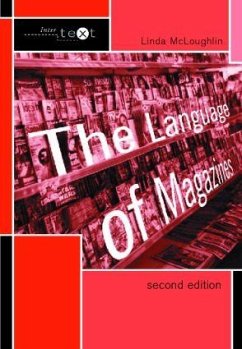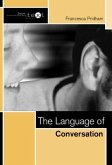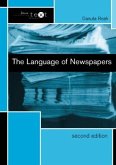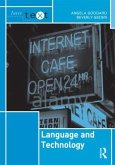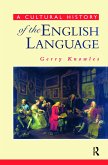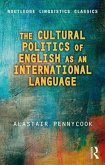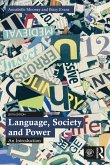Linda McLoughlin (UK Liverpool Hope University)
The Language of Magazines
Linda McLoughlin (UK Liverpool Hope University)
The Language of Magazines
- Broschiertes Buch
- Merkliste
- Auf die Merkliste
- Bewerten Bewerten
- Teilen
- Produkt teilen
- Produkterinnerung
- Produkterinnerung
Offers students a hands-on practical experience of textual analysis focused on magazines. It combines practical activities with texts, followed by commentaries and suggestions for further reading.
Andere Kunden interessierten sich auch für
![The Language of Conversation The Language of Conversation]() Francesca PridhamThe Language of Conversation32,99 €
Francesca PridhamThe Language of Conversation32,99 €![The Language of Speech and Writing The Language of Speech and Writing]() Sandra Cornbleet (UK University of Nottingham)The Language of Speech and Writing31,99 €
Sandra Cornbleet (UK University of Nottingham)The Language of Speech and Writing31,99 €![The Language of Newspapers The Language of Newspapers]() Danuta ReahThe Language of Newspapers26,99 €
Danuta ReahThe Language of Newspapers26,99 €![Language and Technology Language and Technology]() Angela Goddard (UK Formerly at York St. John University)Language and Technology23,99 €
Angela Goddard (UK Formerly at York St. John University)Language and Technology23,99 €![A Cultural History of the English Language A Cultural History of the English Language]() Gerry KnowlesA Cultural History of the English Language51,99 €
Gerry KnowlesA Cultural History of the English Language51,99 €![The Cultural Politics of English as an International Language The Cultural Politics of English as an International Language]() Alastair Pennycook (University of Technology, Sydney, Australia)The Cultural Politics of English as an International Language63,99 €
Alastair Pennycook (University of Technology, Sydney, Australia)The Cultural Politics of English as an International Language63,99 €![Language, Society and Power Language, Society and Power]() Annabelle MooneyLanguage, Society and Power34,99 €
Annabelle MooneyLanguage, Society and Power34,99 €-
-
-
Offers students a hands-on practical experience of textual analysis focused on magazines. It combines practical activities with texts, followed by commentaries and suggestions for further reading.
Produktdetails
- Produktdetails
- Intertext
- Verlag: Taylor & Francis Ltd
- Seitenzahl: 128
- Erscheinungstermin: 23. März 2000
- Englisch
- Abmessung: 246mm x 174mm x 7mm
- Gewicht: 248g
- ISBN-13: 9780415214247
- ISBN-10: 0415214246
- Artikelnr.: 22082905
- Herstellerkennzeichnung
- Libri GmbH
- Europaallee 1
- 36244 Bad Hersfeld
- gpsr@libri.de
- Intertext
- Verlag: Taylor & Francis Ltd
- Seitenzahl: 128
- Erscheinungstermin: 23. März 2000
- Englisch
- Abmessung: 246mm x 174mm x 7mm
- Gewicht: 248g
- ISBN-13: 9780415214247
- ISBN-10: 0415214246
- Artikelnr.: 22082905
- Herstellerkennzeichnung
- Libri GmbH
- Europaallee 1
- 36244 Bad Hersfeld
- gpsr@libri.de
Linda McLoughlin is a part-time lecturer in English language at Edge Hill College, Ormskirk, Lancashire. She has designed and taught BA and MA courses in English language, specialising in language and gender.
Introduction Unit one: What is a magazine? What is a magazine? What types of magazines are there? Who produces magazines? Unit two: The wrapping: front covers
Ideal-reader images
What's in a name?: magazine titles
Visual images
Layout and graphology
The front cover as preview
Putting words together
Creating variety: sentence types
Sentence functions
Problems and solutions
Tricks of language
Unit three: Leafing through: the composition of the text
Front of house: the contents page
The composition of pages
Unit four: In-house: magazine contents
Horoscopes
Readers' letters
The problem page
Magazine narratives: readers' true stories
Dialogue within the text
Unit five: Who am I?: the relationship between the text producer and interpreter
Constructing subject positions
The ideal-reader
The identity of the text producer
The relationship between the text producer and reader
The editorial
Resisting subject positions
Unit six: The discourse of magazines
Discourse
Linguistic determinism: ideological Viewpoints
Text
Tracing patterns in language
Lexical cohesion
Grammatical cohesion
The discourse of magazines
Patterns of word choices
Unit seven: Representations of women and men: constructing femininity, masculinity and sexuality
Femininities and masculinities
Constructing femininities and masculinities: the advertorial
Constructing sexuality
Ideal-reader images
What's in a name?: magazine titles
Visual images
Layout and graphology
The front cover as preview
Putting words together
Creating variety: sentence types
Sentence functions
Problems and solutions
Tricks of language
Unit three: Leafing through: the composition of the text
Front of house: the contents page
The composition of pages
Unit four: In-house: magazine contents
Horoscopes
Readers' letters
The problem page
Magazine narratives: readers' true stories
Dialogue within the text
Unit five: Who am I?: the relationship between the text producer and interpreter
Constructing subject positions
The ideal-reader
The identity of the text producer
The relationship between the text producer and reader
The editorial
Resisting subject positions
Unit six: The discourse of magazines
Discourse
Linguistic determinism: ideological Viewpoints
Text
Tracing patterns in language
Lexical cohesion
Grammatical cohesion
The discourse of magazines
Patterns of word choices
Unit seven: Representations of women and men: constructing femininity, masculinity and sexuality
Femininities and masculinities
Constructing femininities and masculinities: the advertorial
Constructing sexuality
Introduction Unit one: What is a magazine? What is a magazine? What types of magazines are there? Who produces magazines? Unit two: The wrapping: front covers
Ideal-reader images
What's in a name?: magazine titles
Visual images
Layout and graphology
The front cover as preview
Putting words together
Creating variety: sentence types
Sentence functions
Problems and solutions
Tricks of language
Unit three: Leafing through: the composition of the text
Front of house: the contents page
The composition of pages
Unit four: In-house: magazine contents
Horoscopes
Readers' letters
The problem page
Magazine narratives: readers' true stories
Dialogue within the text
Unit five: Who am I?: the relationship between the text producer and interpreter
Constructing subject positions
The ideal-reader
The identity of the text producer
The relationship between the text producer and reader
The editorial
Resisting subject positions
Unit six: The discourse of magazines
Discourse
Linguistic determinism: ideological Viewpoints
Text
Tracing patterns in language
Lexical cohesion
Grammatical cohesion
The discourse of magazines
Patterns of word choices
Unit seven: Representations of women and men: constructing femininity, masculinity and sexuality
Femininities and masculinities
Constructing femininities and masculinities: the advertorial
Constructing sexuality
Ideal-reader images
What's in a name?: magazine titles
Visual images
Layout and graphology
The front cover as preview
Putting words together
Creating variety: sentence types
Sentence functions
Problems and solutions
Tricks of language
Unit three: Leafing through: the composition of the text
Front of house: the contents page
The composition of pages
Unit four: In-house: magazine contents
Horoscopes
Readers' letters
The problem page
Magazine narratives: readers' true stories
Dialogue within the text
Unit five: Who am I?: the relationship between the text producer and interpreter
Constructing subject positions
The ideal-reader
The identity of the text producer
The relationship between the text producer and reader
The editorial
Resisting subject positions
Unit six: The discourse of magazines
Discourse
Linguistic determinism: ideological Viewpoints
Text
Tracing patterns in language
Lexical cohesion
Grammatical cohesion
The discourse of magazines
Patterns of word choices
Unit seven: Representations of women and men: constructing femininity, masculinity and sexuality
Femininities and masculinities
Constructing femininities and masculinities: the advertorial
Constructing sexuality

